Visual associative memory
simulates the McCollough effect
Paul V. Maximov and Vadim V. Maximov
Institute for Problems of Information Transmission,
Russian Academy of Sciences, 101447 Moscow, Russia
A paper version of the poster was presented
at the 20th European Conference on Visual Perception
(Helsinki, Finland, 24-29 August, 1997)
- visit Pion Ltd WWW site for details
*
The McCollough effect
Adaptation
Look at the two coloured grids below for a few minutes, shifting your gaze from one grid
to another from time to time. There is no need to stare at single point on a grid.
Do not change a viewing distance significantly.
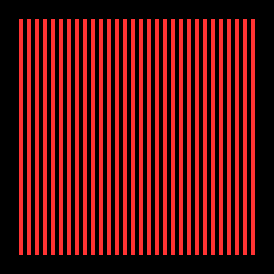
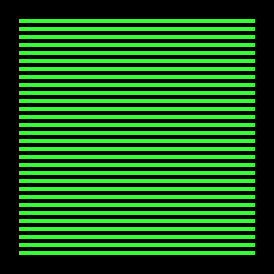
Testing
Originally the patterns below look as achromatic.
After the inspection of two adapting chromatic grids displayed above, similarly oriented black-and-white test gratings
appear tinted with complementary colours.

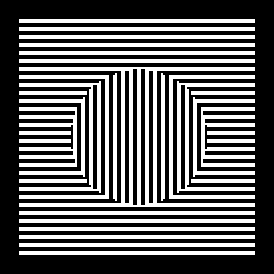
Introduction
The orientation-contingent colour aftereffect, or the McCollough effect (ME) refers to the phenomenon
that, after a few minutes' exposure to gratings differing in both orientation and colour, subjects perceive
similarly oriented achromatic gratings as if they were tinted with complementary hues.
The traditional explanation of the ME as an adaptation of detectors selective for colour and orientation
suffers from a number of inconsistencies:
- the ME lasts much longer than ordinary adaptation, the decay of the effect being completely arrested
during a night's sleep, or by occluding the eye for a long time,
- the strength of the ME is practically independent of the intensity of adapting light,
- a set of related pattern-contingent aftereffects discovered later would require, for explanation on
similar lines, new detectors specific to other patterns.
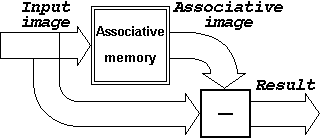 These properties can be explained, however,
in the framework of an associative memory
and novelty filters. It is supposed that in the
course of "adaptation" the colour grid patterns
are stored in the memory. When testing with
an achromatic grid, the associative image of
the grid with same orientation is recalled from
the memory and subtracted from the input image,
leaving in the resulting image only novel feature,
namely, a complementary colour of the grid.
These properties can be explained, however,
in the framework of an associative memory
and novelty filters. It is supposed that in the
course of "adaptation" the colour grid patterns
are stored in the memory. When testing with
an achromatic grid, the associative image of
the grid with same orientation is recalled from
the memory and subtracted from the input image,
leaving in the resulting image only novel feature,
namely, a complementary colour of the grid.
The Model
A computational model of novelty filter has been developed which consists of
- an input layer of two (left and right eyes) square matrices with two analog receptors (red and green)
in each pixel, input images (vectors xit) entering the input layer each time t,
- an isomorphic associative neural layer, each neuron (i) being synaptically
connected with all receptors (j) of both eyes except
for the receptor with the same number i:

- an output layer calculating the
difference between input and
associative images:
zi = xi - yi .
 Modification of synaptic efficacies wij conforms to the following rule:
wijt+1 = wijt + eþxjtþzit ,
where e is some constant, describing the synaptic plasticity.
Modification of synaptic efficacies wij conforms to the following rule:
wijt+1 = wijt + eþxjtþzit ,
where e is some constant, describing the synaptic plasticity.
Results
- After a few presentations of coloured gratings the model displays the ME, which is slowly destroyed
by subsequent presentations of random pictures, but is rapidly erased (with the rate of learning) by
presentation of achromatic grids. The ratio of these rates depends on the number of synapses in
associative neurons (dimensions of the receptor matrix). With matrices 6x6 it is equal to 20, and
with a sufficiently large receptor matrix (say, 40x40) the effect would last a thousand times longer
than the period of learning, as real ME does.
- Synaptic connections of the associative neurons with receptors after the adaptation show clear colour
specific grid pattern of alternating excitatory and inhibitory stripes. So, necessary structure of the
receptive field (RF) of detectors selective to colour and orientation is constructed as a result of learning.
- The rate of learning depends on the intensity of the adapting stimuli (according to a quadratic law),
but the final strength of the effect does not.
- The strength of the effect is not changed by continuous darkness.
- Like the real ME, the model does not display interocular transfer,
- but with other adapting patterns it shows the disparity-contingent colour after-effect,
thus confirming potential connections of associative neurons with both eyes.
- The model can account for different pattern-contingent colour after-effects
(e.g., the spatial-frequency-contingent colour after-effect) without assuming any predetermined
specific detectors. Such detectors are constructed in the course of adaptation to specific stimuli.
One-eyed version. Temporal properties
| Random stimulation |
Adaptation to colour grids |
Random stimulation |
Stimulation by achromatic grids |
 |
 |
 |
 |
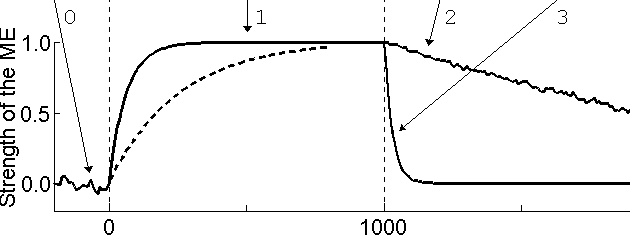 Time courses of the McCollough effect in the model during (1) an adaptation to alternating colour grids
and (2) a subsequent desadaptation with random stimuli or (3) a clearing off the effect with black-and-white
test grids. Before the adaptation the model was subjected to random stimulation (0).
Time courses of the McCollough effect in the model during (1) an adaptation to alternating colour grids
and (2) a subsequent desadaptation with random stimuli or (3) a clearing off the effect with black-and-white
test grids. Before the adaptation the model was subjected to random stimulation (0).
The rate of decay in the case of tests with specific stimuli (3) is 20 times that of the random desadaptation (2).
Receptive fields structure
There are no predetermined specific detectors selective to orientation and colour in the model.
Associative neurons with the properties of such detectors appear after adaptation to coloured grids.
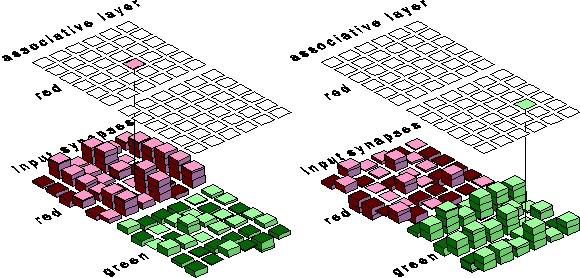
| RF structure of a 'red' associative neuron after
1000 steps of adaptation to red vertical and green
horizontal grids. |
RF structure of a 'green' associative neuron after
the same adaptation. |
The height of the bars represents the synaptic weight w of the contacts of the neuron with
corresponding receptors. Inhibitory contacts are shown with bars oriented downwards.
Note the striped structure of the RFs: the red neuron makes vertically oriented excitatory zones
with red receptors and random connections with green ones, and vice versa, the green neuron makes
horizontally oriented zones with green receptors.
Spatial-frequency-contingent colour after-effect
 Besides the ordinary McCollough effect
a spatial-frequency-contingent colour
after-effect can be produced in the model
by adaptation to coloured grids of the
same orientation but differing in spatial
frequency.
Besides the ordinary McCollough effect
a spatial-frequency-contingent colour
after-effect can be produced in the model
by adaptation to coloured grids of the
same orientation but differing in spatial
frequency.
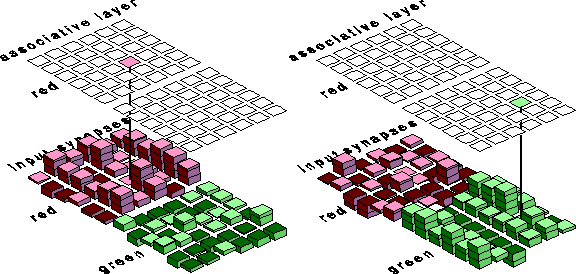 RF structures of 'red' and 'green' associative neurons after 1000 steps of adaptation to close red and sparse
green vertical grids.
RF structures of 'red' and 'green' associative neurons after 1000 steps of adaptation to close red and sparse
green vertical grids.
In contrast to the ordinary ME here the green neuron makes broad alternating excitatory and inhibitory
zones of contacts with green receptors oriented vertically.
Two-eyed version. Lack of the interocular transfer
In the model, in spite of the inherent connection of the associative neurons with both eyes
- after adaptation of one eye to coloured grids, the ME cannot be detected for the unadapted (closed) eye,
- after subsequent adaptation of that eye to grids of the opposite colours, different colour after-effects can be
produced for different eyes simultaneously.
| Random stimulation |
Adaptation to colour grids
(left eye occluded) |
Adaptation to colour grids
(right eye occluded) |
Random stimulation |
| left eye |
right eye |
 |
 |
|
| left eye |
right eye |
 |
 |
|
| left eye |
right eye |
 |
 |
|
| left eye |
right eye |
 |
 |
|

Independent decays of the ME in the eyes
| Random stimulation |
Random stimulation
(left eye occluded) |
Random stimulation |
| left eye |
right eye |
 |
 |
|
| left eye |
right eye |
 |
 |
|
| left eye |
right eye |
 |
 |
|
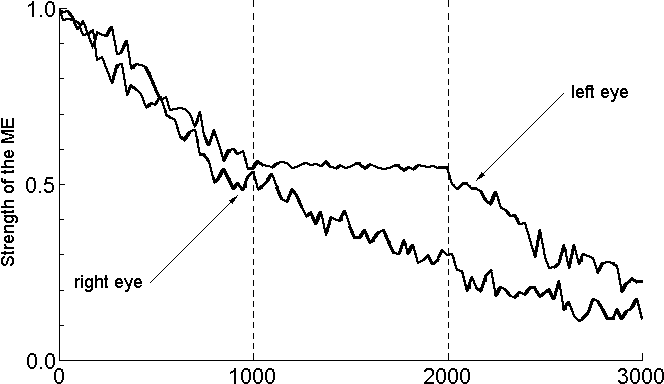
In the model, random stimulation of eyes causes nearly exponential decay of the ME
that is completely arrested by occlusion of an eye.
Disparity-contingent colour after-effect
In spite of the apparent independence
of two eyes a specific binocular after-effect
can be produced in the model by adaptation
to coloured grids of the same orientation
but differing in disparity.
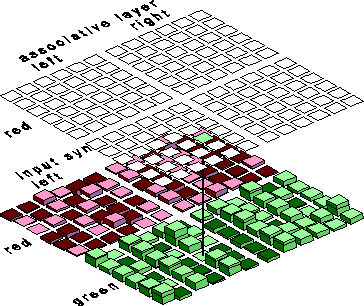 RF structure of a left-eye 'green' associative
neuron after 1000 steps of adaptation to red
and green vertical grids differing in disparity
(as shown abowe right).
The neuron makes alternating excitatory
and inhibitory zones of contacts with green
receptors of both eyes and random contacts
with red receptors.
RF structure of a left-eye 'green' associative
neuron after 1000 steps of adaptation to red
and green vertical grids differing in disparity
(as shown abowe right).
The neuron makes alternating excitatory
and inhibitory zones of contacts with green
receptors of both eyes and random contacts
with red receptors.
| left eye |
right eye |
|
 |
 |
This black-and-white test stimulus will 'look' green for the model after the adaptation. |
| left eye |
right eye |
|
 |
 |
This black-and-white test stimulus will 'look' red for the model after the adaptation. |
Questions and comments to
Back to IITP Laboratory 8 Activity Page
Back to IITP Electronic Posters Page
Back to IITP Projects Page ( IITP russian Projects Page )
Last Update: 23 February, 1999






 These properties can be explained, however,
in the framework of an associative memory
and novelty filters. It is supposed that in the
course of "adaptation" the colour grid patterns
are stored in the memory. When testing with
an achromatic grid, the associative image of
the grid with same orientation is recalled from
the memory and subtracted from the input image,
leaving in the resulting image only novel feature,
namely, a complementary colour of the grid.
These properties can be explained, however,
in the framework of an associative memory
and novelty filters. It is supposed that in the
course of "adaptation" the colour grid patterns
are stored in the memory. When testing with
an achromatic grid, the associative image of
the grid with same orientation is recalled from
the memory and subtracted from the input image,
leaving in the resulting image only novel feature,
namely, a complementary colour of the grid.







 Besides the ordinary McCollough effect
a spatial-frequency-contingent colour
after-effect can be produced in the model
by adaptation to coloured grids of the
same orientation but differing in spatial
frequency.
Besides the ordinary McCollough effect
a spatial-frequency-contingent colour
after-effect can be produced in the model
by adaptation to coloured grids of the
same orientation but differing in spatial
frequency.








